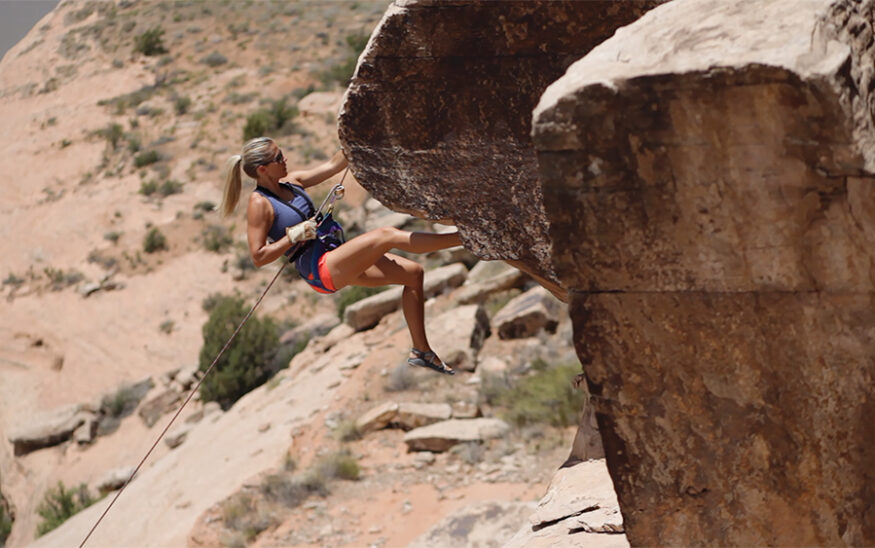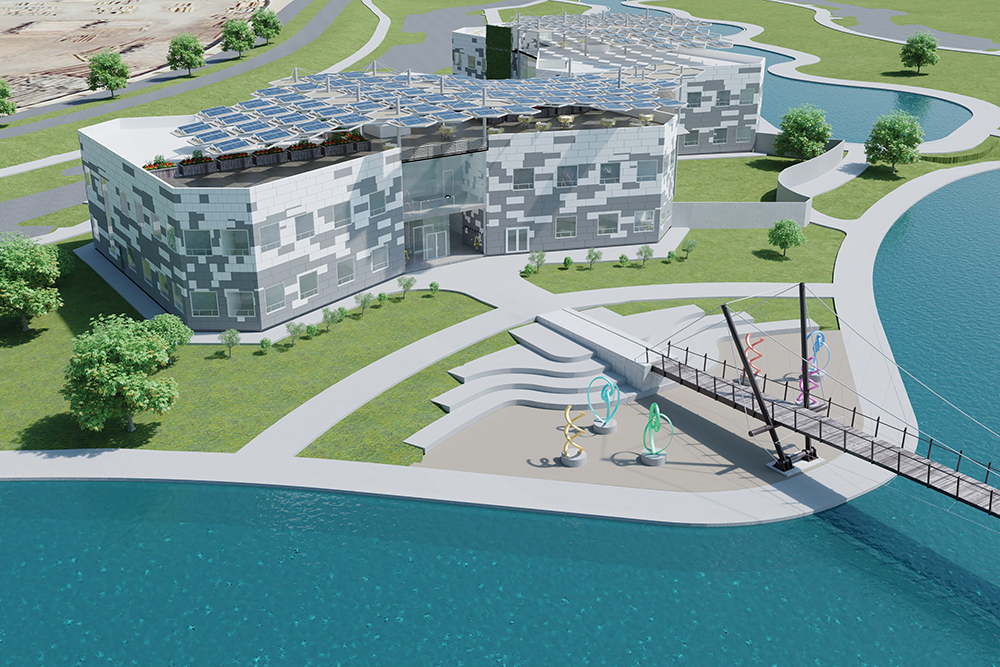Putting a Value on Public Lands
Outdoor and energy industries work toward coexistence
Eric Peterson //October 25, 2018//


Putting a Value on Public Lands
Outdoor and energy industries work toward coexistence
Eric Peterson //October 25, 2018//

Colorado boasts 14.5 million acres of National Forest Service land and another 8.4 million acres overseen by the Bureau of Land Management. That’s more than 34 percent of the state.
Colorado’s public lands are not just vast; they’re also a huge economic driver. The numbers are staggering for both of the big industries that rely on the state’s public lands: energy and outdoor recreation.
Both are heavyweights. The Boulder-based Outdoor Industry Association (OIA) estimates outdoor recreation is a $28 billion industry in Colorado, about 60 percent higher than the national average on a per-capita basis. The American Petroleum Institute has pegged oil and gas as a $31 billion industry in the state.
Nationally, outdoor recreation is a behemoth: Americans spend $887 billion a year annually in the U.S., according to OIA data. That’s more than twice what Americans spend on oil and gas in a given year.
“We have economic data that shows we’re 2 percent of [national] GDP, and growing faster nationally than GDP,” OIA Executive Director Amy Roberts says. She cites a 2016 report from the federal Bureau of Economic Analysis that found outdoor recreation was a bigger industry than legal services or agriculture.
That economic output is inextricably tied to the presence of public lands. “We see public lands as the infrastructure for the outdoor recreation economy in the same way highways are infrastructure for transportation,” Roberts says.
But the industry often doesn’t get its due when it comes to policy-making and economic development. “We’re a multi-billion-dollar economy,” says Luis Benitez, director of the Colorado Outdoor Recreation Industry Office. “We’re actually bigger than the auto industry in the United States.”
Benitez notes that the maintenance of infrastructure — trail projects, cleanup programs and the like — is largely volunteer work. “It’s like the auto industry having volunteer engineers on the weekends,” he laughs.

Blame that on a lack of funding. The federal Land and Water Conservation Fund generates about $2.5 million a day from offshore drilling fees, but it has been funded to its authorized cap of $900 million only twice since its establishment in the mid-1960s. Congress “tends to spend it on other needs,” Roberts says, even with current maintenance backlogs of about $12 billion at the National Park Service and $8 billion at the National Forest Service.
“We feel we’re paying enough into the Treasury,” Roberts says, “but we’re not seeing an investment back.”
Benitez says it is up to Colorado to devise new funding mechanisms. “We can’t keep looking to D.C. with our hands out,” he says.
Regardless, Colorado is already reaping rewards from a strong commitment to conservation of public lands. The Outdoor Retailer (OR) show moving to Denver from Salt Lake City is a crucible of the public lands debate; OIA is heavily involved as the event’s title sponsor and association partner.
After leaders in Utah declined to reverse course on several issues viewed as anti-public lands, the show started looking for a new home in 2017. OR’s owner, Emerald Expositions, has been “super clear,”
Benitez says. “If Colorado shifts, that would put everything back on the table. You can’t plant the biggest gathering on Earth for this industry in a state that doesn’t care about these issues.”
Roberts points to bipartisan support for the protection of public lands from Colorado politicians. “Even (Republican U.S. Rep. Scott) Tipton and (Democratic U.S. Sen. Michael) Bennet came together,” she says of the recent review of national monuments by Interior Secretary Ryan Zinke.
Colorado also has dedicated funding for relevant projects in the Great Outdoors Colorado, a fund that has committed more than $1.1 billion in Colorado Lottery proceeds to parks and other outdoor projects since 1992, or about $40 million a year.
OR’s move “just reflected the industry’s commitment to support public lands,” Roberts says. “That convention brings amazing economic returns to the place where it is held.”
But it’s just one of many fiscal returns from public lands. “Once you preserve an area, there’s an opportunity to build an entire economy around it,” Roberts says, citing Ogden, Utah, and Bentonville, Arkansas, as models. “I think the money’s there, it just requires leadership. Almost every region in the country has that opportunity. You don’t have to be Yosemite.”
In Colorado, officials in places like Montrose and Paonia have increasingly looked to the outdoor industry for economic development. Benitez calls Mesa County, home of Fruita, Grand Junction and Palisade, “a perfect example of a boom/bust cycle” that traditionally comes with an energy-centric economy. In recent years, local leaders have elevated the idea of outdoor recreation as an economic driver.
“Fruita and Grand Junction have both been dependent on resource extraction,” Roberts agrees. “They lost a lot of the next generation when [the energy] industry was not as strong. They looked around and said, ‘What are the natural resources we can use in a different way?’”
The answer surrounded them: Public lands make up about 75 percent of Mesa County’s land area. They’re not only a source of economic activity for drilling but also a catalyst for the county’s strong outdoor industry.
“We love our public lands,” says Robin Brown, executive director of the Grand Junction Economic Partnership. “Who’s paying the bills in this community? It’s companies that depend on public lands.”
Brown describes her vision for “mixed-use” public lands that accommodate both natural gas wells and mountain biking trails. “We could have mountain bike trails going in and out of jack pumps,” she says. “I think there’s a sense these two industries are at odds, and I think Mesa County can be a place where we prove that wrong.”
Low oil and gas prices in 2015 forced local leaders to look at other industries. The common perception of outdoor recreation was a “soft industry,” says Brown, with “seasonal, minimum-wage jobs.”
 That’s when Sarah Shrader, co-founder of zipline and ropes-course manufacturer Bonsai Design in Grand Junction, launched the Outdoor Recreation Coalition of the Grand Valley to get the word out that outdoor recreation represented about 2,000 jobs and $300 million a year to Mesa County.
That’s when Sarah Shrader, co-founder of zipline and ropes-course manufacturer Bonsai Design in Grand Junction, launched the Outdoor Recreation Coalition of the Grand Valley to get the word out that outdoor recreation represented about 2,000 jobs and $300 million a year to Mesa County.
“The outdoor recreation industry is an economic powerhouse that provides high-paying jobs, and it’s sustainable,” Shrader says, noting that Bonsai Design pays employees 120 percent of the county average. “We’ve put all of our eggs in one basket, and it just hasn’t worked.”
The local mindset has quickly changed. “In three years, everything that [the Outdoor Recreation Coalition] wanted to accomplish has been accomplished,” Brown says. Members now serve on the boards of many local organizations and the message of the industry’s economic heft gets repeated at every opportunity.
“So much of change comes from face-to-face discussions in local communities,” Shrader says of outreach. “We are asked to be at the table. I don’t know if that was happening three years ago.”
 There’s a win/win with local vendors to the energy industry and outdoor-oriented manufacturers in Grand Junction, where metalworkers, welders and supply yards are readily available. “That infrastructure was already in Grand Junction because of oil and gas,” Shrader says. “You’re not going to find the same infrastructure somewhere else unless we went to a big city. We’re keeping those people at work and those companies alive. That’s good for them, and that’s good for us.”
There’s a win/win with local vendors to the energy industry and outdoor-oriented manufacturers in Grand Junction, where metalworkers, welders and supply yards are readily available. “That infrastructure was already in Grand Junction because of oil and gas,” Shrader says. “You’re not going to find the same infrastructure somewhere else unless we went to a big city. We’re keeping those people at work and those companies alive. That’s good for them, and that’s good for us.”
Proximity to public lands also increases property values, contributes to quality of life, and lures talent and companies like little else. About a third of the companies that inquire about relocating to the Grand Junction area are outdoor-related, Brown says.
“You step out your front door and you have over 10,000 miles of trails on public lands,” she says. “That quality of life and access to the outdoors plays a huge role in recruiting companies to Mesa County.”
To this end, Bonsai Design is currently developing a riverfront campus, Las Colonias, that’s scheduled to open in spring 2019. It’s already attracted tenants from other cities, but the bigger story is that public lands help draw medical, aviation and other professionals.
Statewide, there’s an ongoing need for dialogue and compromise. “The reality is — and this is a hard one to stomach — it can’t be an either/or. It needs to be a both/and,” Benitez says. “We’re a blended economy. We need energy.”
Adds Roberts: “Colorado is a great place to be because it is a purple state, and it is a balanced economy.”
Jay Getzel, president of Golden-based Mountainsmith, is active with Conservation Colorado’s Colorado Outdoor Business Alliance. He strikes a more combative tone than most. “It’s not just about protecting public lands, but not allowing fossil fuel companies in there to perpetuate a dying industry,” he says.
From Getzel’s point of view, protecting public lands is investing in the state’s future. “The recreation economy will be there for many years to come, but those resources that you pull out of the ground are finite,” he says. “There’s a much longer tail. It’s a more sustainable revenue stream.”
It’s paying dividends now, he adds. “We gained this phenomenal trade show. We’re driving industry awareness. It gives the state of Colorado a really good recruitment tool.”

When Mountainsmith posts an entry-level job in customer service, Getzel says, “I have people with MBAs applying because they want to move to Colorado.”
Perks like eight miles of singletrack and Mount Galbraith out the back door are a big part of the draw. “You can go bag a 7,000-foot peak during lunch,” Getzel says. “That wouldn’t be available if our company was based in Manhattan or the Bay Area. I think it’s really interesting how desirable and how marketable Colorado is.
“Colorado has this cachet it needs to capitalize on to continue to drive tourism,” he continues. “Any affront to our public lands is going to hinder us marketing ourselves as a place to go play.”

























